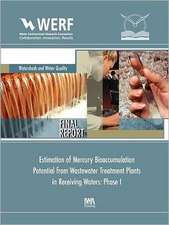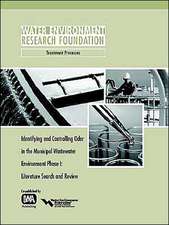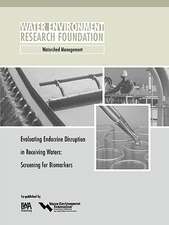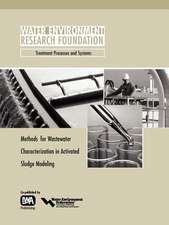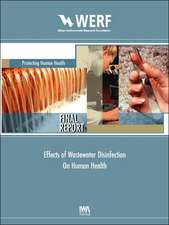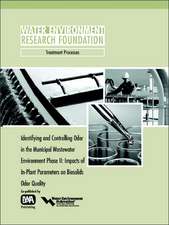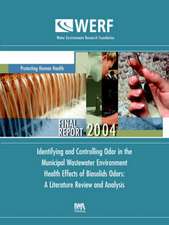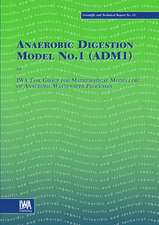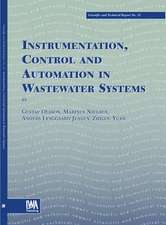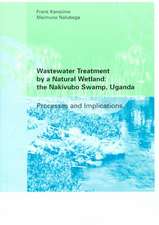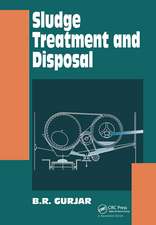Natural Wastewater Treatment Systems
Autor Ronald W. Crites, E. Joe Middlebrooks, Robert K. Bastianen Limba Engleză Hardback – 14 mar 2014
What’s New in the Second Edition:
This revised edition includes current design and regulatory and operational developments in the natural wastewater treatment field. It provides detailed examples and analyses along with significant operational data in each chapter. It also considers how processes provide passive treatment with a minimum of mechanical elements, and describes new approaches to partially mixed ponds, including dual-powered aeration ponds.
- Introduces the planning procedures and treatment mechanisms responsible for treatment in ponds, wetlands, land application, and soil absorption systems
- Provides new case studies of constructed wetlands and water reuse systems
- Presents design criteria and methods of pond treatment and pond effluent upgrading
- Describes constructed wetlands design procedures, process applications, treatment performance data, and land treatment concepts and design equations
- Includes information on constituents of emerging concern (CEC) and their fate in natural systems
Designed for practicing wastewater engineers and scientists involved in the planning, design, and operation of ponds, wetlands, land treatment, biosolids, and onsite soil-based treatment systems, the book integrates many natural treatment systems into one single source.
Preț: 1021.26 lei
Preț vechi: 1445.77 lei
-29% Nou
Puncte Express: 1532
Preț estimativ în valută:
195.41€ • 204.05$ • 161.37£
195.41€ • 204.05$ • 161.37£
Carte tipărită la comandă
Livrare economică 15-29 aprilie
Preluare comenzi: 021 569.72.76
Specificații
ISBN-13: 9781466583269
ISBN-10: 1466583266
Pagini: 552
Ilustrații: 92 black & white illustrations
Dimensiuni: 156 x 234 x 36 mm
Greutate: 0.82 kg
Ediția:Revised
Editura: CRC Press
Colecția CRC Press
ISBN-10: 1466583266
Pagini: 552
Ilustrații: 92 black & white illustrations
Dimensiuni: 156 x 234 x 36 mm
Greutate: 0.82 kg
Ediția:Revised
Editura: CRC Press
Colecția CRC Press
Public țintă
Academic and Professional Practice & DevelopmentCuprins
Natural Wastewater Treatment Systems: An Overview. References. Planning, Feasibility Assessment, and Site Selection. References. Basic Process Responses and Interactions. Design of Wastewater Pond Systems. Pond Modifications for Polishing Effluents. Methods. References. Free Water Surface Constructed Wetlands. Subsurface and Vertical Flow Constructed Wetlands. References. Land Treatment Systems. References. Sludge Management and Treatment. Systems. References. On-Site Wastewater Systems. References. Appendices. Index.
Notă biografică
Ronald W. Crites is a senior associate with Brown and Caldwell in Davis, California. He consults on land treatment, water recycling and reuse, constructed wetlands, biosolids land application, decentralized wastewater treatment, and industrial wastewater land application systems. He received his BS in civil engineering from California State University in Chico and his MS and engineer’s degree in sanitary engineering from Stanford University. He is the recipient of the 2009 Camp Applied Research Medal from Water Environment Federation for innovation in natural systems. He has 44 years of experience in wastewater treatment and reuse experience. He has authored or coauthored over 200 technical publications, including seven textbooks. He is a registered civil engineer in California, Hawaii, and Oregon.
E. Joe Middlebrooks is a consulting environmental engineer based in Superior, Colorado. His 45 years as an engineering college professor as well as administrative positions, including dean of engineering at Utah State University, provided a platform for his extensive research and contributions to the environment engineering field. He received his BS and MS in civil engineering from the University of Florida and his PhD in civil engineering (environmental engineering) from Mississippi State University, followed by postdoctoral studies at the University of California at Berkeley. He has authored or coauthored 14 books and over 300 articles and reports.
Robert K. Bastian is a senior environmental scientist in the office of wastewater management at the U.S. Environmental Protection Agency in Washington, DC. He has extensive experience dealing with natural systems for wastewater treatment, wastewater, and biosolids reuse practices, and has coordinated the development of numerous agency policy and guidance documents, technology assessments, planning and design guidance documents, demonstration projects, and special studies related to treatment technologies and management practices involving natural systems. He received his BS and MS in biology, earth sciences, and mathematics from Bowling Green State University in Ohio and served as an officer in the U.S. Army Corps of Engineers.
Sherwood C. Reed (1932–2003) was an environmental engineer who was a leader in the planning and design of constructed wetlands and land treatment systems. He was the principal of Environmental Engineering Consultants (E.E.C.). He was a graduate of the University of Virginia (BSCE, 1959) and the University of Alaska (MS, 1968) and had a distinguished career with the U.S. Army Corps of Engineers, during which he spent most of his time at the Cold Regions Research and Engineering Laboratory (CRREL) in Hanover, New Hampshire. He was the author of four textbooks and over 100 technical articles.
E. Joe Middlebrooks is a consulting environmental engineer based in Superior, Colorado. His 45 years as an engineering college professor as well as administrative positions, including dean of engineering at Utah State University, provided a platform for his extensive research and contributions to the environment engineering field. He received his BS and MS in civil engineering from the University of Florida and his PhD in civil engineering (environmental engineering) from Mississippi State University, followed by postdoctoral studies at the University of California at Berkeley. He has authored or coauthored 14 books and over 300 articles and reports.
Robert K. Bastian is a senior environmental scientist in the office of wastewater management at the U.S. Environmental Protection Agency in Washington, DC. He has extensive experience dealing with natural systems for wastewater treatment, wastewater, and biosolids reuse practices, and has coordinated the development of numerous agency policy and guidance documents, technology assessments, planning and design guidance documents, demonstration projects, and special studies related to treatment technologies and management practices involving natural systems. He received his BS and MS in biology, earth sciences, and mathematics from Bowling Green State University in Ohio and served as an officer in the U.S. Army Corps of Engineers.
Sherwood C. Reed (1932–2003) was an environmental engineer who was a leader in the planning and design of constructed wetlands and land treatment systems. He was the principal of Environmental Engineering Consultants (E.E.C.). He was a graduate of the University of Virginia (BSCE, 1959) and the University of Alaska (MS, 1968) and had a distinguished career with the U.S. Army Corps of Engineers, during which he spent most of his time at the Cold Regions Research and Engineering Laboratory (CRREL) in Hanover, New Hampshire. He was the author of four textbooks and over 100 technical articles.
Recenzii
"This text provides a thorough explanation on how soil and plants can successfully sustain microbial populations in the treatment of wastewater and also how these processes produce lower amounts of residual solids, and use little or no chemicals… The book is of particular interest for practicing wastewater engineers and scientists involved in the planning , design, and operation of ponds, wetlands, land treatment, biosolids, and onsite soil-based treatment systems."
—International Journal of Environmental Analytical Chemistry, 2014
"The first edition of Natural Wastewater Treatment Systems has long served as the basis for understanding the design and performance of natural systems in treating wastewater. This updated edition will only enhance its recognition as an industry standard."
––Michael Hines, M.S., P.E., Founding Principal, Southeast Environmental Engineering, LLC
"In an age of concrete, steel, and chemicals — and their associated carbon/energy footprint — it is with whole-hearted enthusiasm that I commend this reference text to any reader who is interested in the common-sense, economical, and environmentally friendly alternative of natural wastewater treatment."
—Michael J. Cook, Idaho Department of Environmental Quality
"… emphasizes a method to assess sites, soils, wastestreams, and available treatment options leading to appropriate solutions for wastewater systems. Designers, regulators, clients and the general public need a reliable reference addressing options and alternatives; this book provides that. … provides a pathway to assure water and nutrients are utilized and recovered effectively and efficiently while protecting public health and the environment with options that are economically feasible."
—A. Robert Rubin, NCSU – BAE, Emeritus Professor
"The second edition of Natural Wastewater Treatment Systems contains sufficient technical material to be scientifcially sound, and yet it it easily comprehended. The authors do an excellent job of translating science and technology into readable text. The examples incorporate lessons learned from operating systems into easily readable text. Each of the technologies addressed utilize a sound desing approach, and this approach is vital to understanding the natural system approach. The four authors collaborated in the development of text that reads as though from a single voice."
—Vadose Zone Journal, December 2015
—International Journal of Environmental Analytical Chemistry, 2014
"The first edition of Natural Wastewater Treatment Systems has long served as the basis for understanding the design and performance of natural systems in treating wastewater. This updated edition will only enhance its recognition as an industry standard."
––Michael Hines, M.S., P.E., Founding Principal, Southeast Environmental Engineering, LLC
"In an age of concrete, steel, and chemicals — and their associated carbon/energy footprint — it is with whole-hearted enthusiasm that I commend this reference text to any reader who is interested in the common-sense, economical, and environmentally friendly alternative of natural wastewater treatment."
—Michael J. Cook, Idaho Department of Environmental Quality
"… emphasizes a method to assess sites, soils, wastestreams, and available treatment options leading to appropriate solutions for wastewater systems. Designers, regulators, clients and the general public need a reliable reference addressing options and alternatives; this book provides that. … provides a pathway to assure water and nutrients are utilized and recovered effectively and efficiently while protecting public health and the environment with options that are economically feasible."
—A. Robert Rubin, NCSU – BAE, Emeritus Professor
"The second edition of Natural Wastewater Treatment Systems contains sufficient technical material to be scientifcially sound, and yet it it easily comprehended. The authors do an excellent job of translating science and technology into readable text. The examples incorporate lessons learned from operating systems into easily readable text. Each of the technologies addressed utilize a sound desing approach, and this approach is vital to understanding the natural system approach. The four authors collaborated in the development of text that reads as though from a single voice."
—Vadose Zone Journal, December 2015
Descriere
This new edition examines all changes and advancements that have taken place since the previous edition published in 2005. It outlines the planning, feasibility assessment, and site selection methods unique to natural processes as well as the basic process responses and interactions governing natural systems. It examines the systems in detail, discussing wastewater pond systems, free water surface constructed wetlands, subsurface and vertical flow constructed wetlands, land treatment, sludge management, and onsite wastewater systems. The book illustrates practical aspects through numerous examples and data tables.








